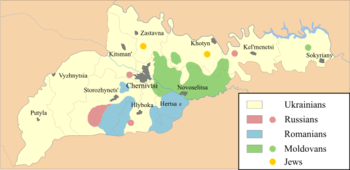Hertza region
Hertza region (Ukrainian: Край Герца, Kraj Herca; Romanian: Ținutul Herța) is a border region within an administrative district (raion) of Hertsa (Herța) in the southern part of Chernivtsi Oblast in southwestern Ukraine, near Romania. The population in 2001 was about 32,300 people, 93% of whom are ethnic Romanians.

History
The territory, historically part of Moldavia, was one of the five districts of the Dorohoi County. In 1940, following the Molotov–Ribbentrop Pact, it was occupied by the Soviet Union and attached to the Ukrainian Soviet Socialist Republic.[1][2] It was recaptured by Romania during 1941–1944 in the course of the Axis attack on the Soviet Union in World War II, until the Red Army captured it again in 1944. Soviet annexation of this territory was internationally recognized by the Paris Peace Treaties in 1947.
Romania and Ukraine have signed and ratified a border agreement and are signatories of international treaties and alliances that denounce any territorial claims. Romanian organisations in the region consider Hertza to be historically Romanian, detached from it by the Soviet Union in 1940 in violation of international law. The correspondent of "New Region" Sergei Vulpe with reference to the Bucharest newspaper Ziua reported on April 17, 2008[3] that the President of Romania, Traian Băsescu stated that if Ukraine wants to annex Transnistria than she should return the southern Bessarabia (Budjak) and the northern Bukovina (Chernivtsi Oblast that includes the Hertza region) to Moldova.